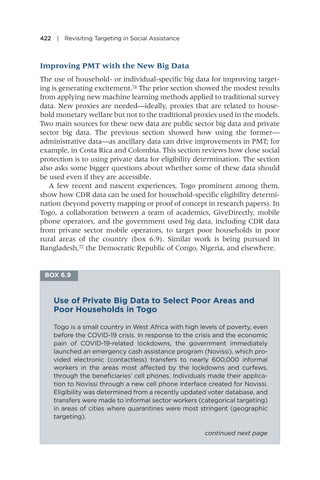422 | Revisiting Targeting in Social Assistance
Improving PMT with the New Big Data The use of household- or individual-specific big data for improving targeting is generating excitement.76 The prior section showed the modest results from applying new machine learning methods applied to traditional survey data. New proxies are needed—ideally, proxies that are related to household monetary welfare but not to the traditional proxies used in the m odels. Two main sources for these new data are public sector big data and private sector big data. The previous section showed how using the former— administrative data—as ancillary data can drive improvements in PMT; for example, in Costa Rica and Colombia. This section reviews how close social protection is to using private data for eligibility determination. The section also asks some bigger questions about whether some of these data should be used even if they are accessible. A few recent and nascent experiences, Togo prominent among them, show how CDR data can be used for household-specific eligibility determination (beyond poverty mapping or proof of concept in research papers). In Togo, a collaboration between a team of academics, GiveDirectly, mobile phone operators, and the government used big data, including CDR data from private sector mobile operators, to target poor households in poor rural areas of the country (box 6.9). Similar work is being pursued in Bangladesh,77 the Democratic Republic of Congo, Nigeria, and elsewhere.
BOX 6.9
Use of Private Big Data to Select Poor Areas and Poor Households in Togo Togo is a small country in West Africa with high levels of poverty, even before the COVID-19 crisis. In response to the crisis and the economic pain of COVID-19-related lockdowns, the government immediately launched an emergency cash assistance program (Novissi), which provided electronic (contactless) transfers to nearly 600,000 informal workers in the areas most affected by the lockdowns and curfews, through the beneficiaries’ cell phones. Individuals made their application to Novissi through a new cell phone interface created for Novissi. Eligibility was determined from a recently updated voter database, and transfers were made to informal sector workers (categorical targeting) in areas of cities where quarantines were most stringent (geographic targeting). continued next page


